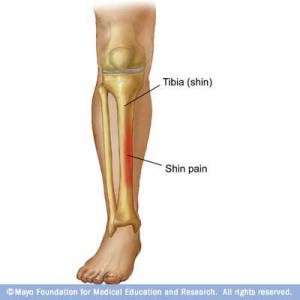Coach Nicole of sparkpeople.com leads you through a short (3-minute) routine of lower legs stretches for the calves and ankles. Take a look at this video to learn different stretches and exercise using a wall. These stretches are great for people with tight calves or weak ankles in general, but may also help prevent and manage shin splint pain. Here are some shin splints prevention tips.
Tag Archives: Shin Splints
How To Prevent Shin Splints During Cardio
Shin splints are painful and can hamper your exercise routine. Learn how to prevent shin splints during cardio in this exercise video and Find out what are the symptoms and causes and causes of shin splints as well as the shin splints treatment.
Shin Splints & Plantar Fasciitis Rehabilitation Video
This video shows shin splints, plantar fasciitis rehabilitation . While on your back, use a strap or belt around the ball of your foot to perform stretch in video. Perform stretch for 5 minutes on each leg 1 to 2 times per day. Foot Massage: Using a massage roller or racket ball or tennis ball on the floor, roll the ball across the length of your foot and over your heel. Apply as much weight as needed to feel pressure but not pain. Do this for 5 minutes each day on both feet. Just click this link to know more about shin splints and other muscle injury.
How To Treat Shin Splints
Treatment techniques for dealing with shin splints can provide tremendous relief to runners and others who suffer. Learn how to treat sports injuries in this video on health and rehabilitation. Click this link and find out what are the shin splints treatment and therapies.
Sports Medicine : Treatments For Shin Splints
Shin splint treatment usually involves changing shoe wear, stretching and exercising to alleviate symptoms. Alleviate the discomfort and inflammation of shin splints with help from a physical therapist in this free video on sports medicine and shin splints. Find out how to treat muscle ailments with help from this free video series on physical therapy. Learn more about shin splints treatment and therapies.
Shin Splints – What is that pain in my shin?
Pain in the shins is not a form of a muscle pull. This is a sign of shin splints.
Shin splints occur when you overuse your lower legs. This condition is a result of inflammation of the large bone in the lower leg, known as the tibia, along with the muscles, tendons and the thin tissue layer covering the bone. Shin splints cause pain in the lower legs, and the discomfort may last even after you stop exercising.
The condition is most commonly seen in athletes whose legs pound a hard surface repeatedly; runners, ballet dancers, hikers, ballet dancers, and basketball players are all prone to shin splints, especially if an athlete increases mileage or activity too quickly. Having low foot arches, or flat feet, can also increase the risk of shin splints, since it can put increased stress on the lower legs.
Oftentimes, a few weeks away from weight-bearing exercise is enough to allow shin splints to clear up. In fact, it’s rare that surgery is necessary to treat shin splints. Still, it’s important to rule out other, potentially more serious conditions, so you should consult a clinician about your pain. He or she may examine your legs, and an X-ray or bone scan may be necessary to make sure that your lower leg pain is not being caused by a stress fracture. The sports medicine specialist may also suggest you undergo physical therapy. Learn more about additional shin splints treatment options.
It’s important that once you begin training again, you start slowly, increasing your mileage bit by bit, to avoid a recurrence of shin splints. Furthermore, stretch and warm up properly before each session.

